Laptop Mag Verdict
This fully rugged convertible tablet can take a serious beating and provides Core i7 power.
Pros
- +
Extremely durable
- +
Super-bright touch display
- +
Speedy Core i7 processor
- +
Fingerprint security
- +
Strong wireless throughput
Cons
- -
No built-in carry handle
- -
Some keys stuck a bit after torture tests
- -
Touchscreen works better with stylus than with fingers
- -
Bottom left corner gets warm
Why you can trust Laptop Mag
Imagine an ultraportable laptop encased in magnesium alloy armor complete with shock-absorbing rubber bumpers. Now envision this device being able to convert from a notebook to a tablet on the fly. That's the Getac V100, a versatile machine that, despite its compact size, is rugged enough to take a serious beating. Designed for those who need a laptop that can survive almost any conditions, this machine also features a speedy Intel Core i7 processor, a state-of-the-art SSD drive, and an ultra-bright screen. It's super tough, and it's fast, but is the V100 worth nearly five grand?
Design
The Getac V100 wouldn't look out of place on a factory floor or on a mountaintop in Afghanistan. This fully rugged notebook is constructed from a gun-metal gray magnesium alloy ringed with black rubber bumpers, and hardy plastic ridges are everywhere. Weighing 6.2 pounds and measuring 11.2 x 8.7 x 1.9 inches, the Getac V100 is technically an ultraportable, though it's on the chunky side, especially considering its relatively small 10.4-inch screen. It's heavier than the similarly sized Panasonic Toughbook 19 (5 pounds), and certainly heftier than the larger, but more lightly armored, Toughbook C1 (3.7 pounds).
The V100 is billed as a rugged laptop that also transforms into a tablet, and the screen swivels to lay flat against its keyboard while in tablet mode. Under the display is a slot for the plastic stylus, which can be used with the system's touchscreen as well as the fingerprint scanner. A sturdy metal latch holds the screen in place in both laptop and tablet modes. While optional straps can be attached to the V100, there's no built-in handle, which makes the notebook a bit of a pain to carry around.
The front edge of the V100 has several buttons that can be used in tablet mode. The buttons are sealed behind a waterproof membrane. You'll find keys for launching the On Screen Display control panel, Sunlight-Readable Mode, RF (toggles wireless), Reset (Control + Alt + Delete), and Software Keyboard. There's a Power button as well, along with one speaker.

Click to enlarge
Around the edges of the V100 are big rubber latches that protect various ports, including Ethernet and modem jacks, a USB and combo USB/eSATA port, and audio out and microphone jacks. Rounding out the list are a serial and VGA out, SD Card reader, and two Type II PCMCIA card slots. The right side of the system has locking compartments for the battery and hard drive.
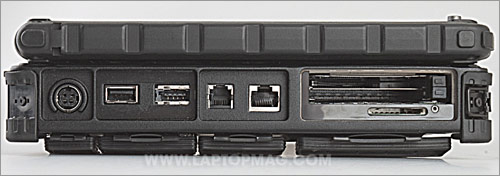
Click to enlarge

Click to enlarge
Rugged Features and Security
Getac built the V100 to meet the MIL-STD 810G and Ingress Protection IP65 standards of durability. That means the device is built to withstand storage temperature extremes of minus 60 to 160 degrees Fahrenheit, operating temperatures of minus 4 to 140 degrees, and blowing dust gusting to wind speeds of up to 40 mph. The V100 can also withstand up to 3.3 gallons of water per minute, or 5.8 inches of rain per hour at winds of 70 mph.
To see just how rugged the V100 really is, we decided to run a few tests of our own. First, we dropped the V100 five times from a height of 3 feet onto a (thinly) carpeted office floor. We then stood on the laptop's lid. After this, we placed a wooden plank on top of the V100 (when closed) and vigorously jumped up and down with all our 210 pounds of weight. To test how well the V100 handled moisture, we poured a 12-ounce cup of water over the V100's keys. After that, we upped the ante by placing the notebook under a faucet, opening the tap, and letting the water flow for 2 minutes. The V100 easily survived all of these tests.
The V100 provides protection from security threats, too. We used the fingerprint reader to log into Windows, but the reader doesn't support website logins). Other security features include Trusted Platform Module (TPM) 1.2 support, which shields unencrypted keys and passwords from software attacks, and a Smart Card reader for hardware authentication.
Heat
The Getac V100 stayed relatively cool despite its fanless design. After streaming a Hulu video for 15 minutes, the laptop registered only 81 degrees on the touchpad. We recorded 89 degrees between the G and H keys on the keyboard and 95 degrees on the underside. The bottom left corner of the laptop did get toasty, measuring 103 degrees. We consider anything above 95 degrees uncomfortable.
Keyboard and Touchpad
The Getac V100's keyboard uses a traditional layout, in which the keys are positioned closely together. The Shift and Ctrl buttons are tiny, but overall the keyboard offered plenty of travel and keys responded with a satisfying click.
Unfortunately, some of the keys sounded as if they were sticking a bit toward the top of the layout after we conducted our torture tests. Getac said it had not heard of this issue and the company told us that this behavior could be caused by a slight gap--due to loose adhesive--between the internal sealed membrane keyboard and the notebook's magnesium frame. While our unit did not come with a backlit keyboard, Getac lists it as an option.
At 2.4 x 1.75 inches, the V100's touchpad is on the small side, but we liked its slightly gritty surface. Though the pad supports finger scrolling along its right side, multitouch controls such as pinching and zooming are not included. The two rubber-coated mouse buttons are large and easy to click.
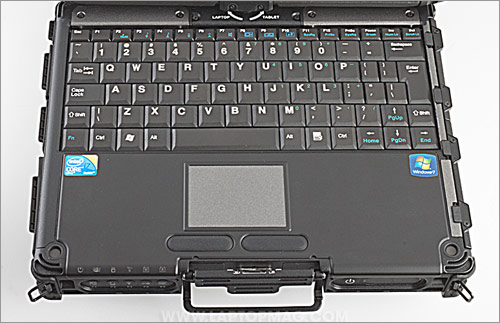
Click to enlarge
Display and Touchscreen
Equipped with a 10.4-inch display, the Getac V100's screen provides a resolution of 1,024 x 768 pixels. Designed to operate in direct sunlight, the V100's screen can pump out a total of 1,200 NITs, which is much higher than most notebooks. Kicking the display into Sunlight-Readable mode ups the screen brightness to its max. Not surprisingly, the screen was easily readable indoors and out, and offered excellent viewing angles.
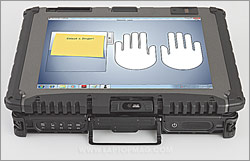
Click to enlargeThe V100 also has a multitouch-enabled resistive touchscreen that works with your fingers as well as with the stylus. We found that the screen was not very responsive to our fingers, while the stylus was optimal for input. For example, we had to press hard with our fingers to execute pinch-to-zoom in web pages and photos. Still, since the screen is resistive, it works when you're wearing gloves, a plus for its intended audience.
Audio and Webcam
The V100's lone front speaker doesn't provide a ton of volume but provides a decent amount of bass. Our test song, "Islands" by The xx, sounded clear and rich, while bass-heavy classic hip-hop streaming from Slacker radio was noticeably tinny.
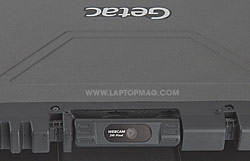
Click to enlargeAlso installed on the V100 is a 2-megapixel camera that swivels 180 degrees. It captured sharp images, but colors looked a bit washed out. The same can be said for Skype video calls. Images were detailed but not as bright as we'd like. The bundled Getac Camera software has a bare-bones feel but has some interesting extras. Users can geotag photos using data from the optional GPS receiver, and there's a built-in barcode reader to look up product details. One oddity is that when the camera is rotated, the software doesn't automatically flip images, so pictures and videos appear upside down.
Performance
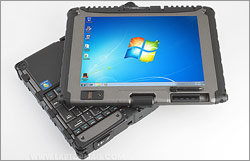
Click to enlargePowered by a 1.2-GHz Intel Core i7 U640 ultra-low voltage processor and equipped with 4GB of RAM, the Getac V100 performed well on our benchmark tests. Its PCMark Vantage score of 5,963 was well above the current 3,804 average for ultraportable laptops. The V100 also bested the current average for rugged machines (5,012) as well as the Panasonic C1 (5,000), which has a faster 2.4-GHz Core i5 CPU but less RAM (2GB).
The V100 lagged behind other rugged machines on our transcode tests, taking 1 minute 33 seconds to convert a 114MB MPEG4 video clip to an AVI file. That's more than 30 seconds longer that the average rugged machine. However, this result was faster than the current ultraportable average of 1:52. That said, the Toughbook C1 completed the same task in just 54 seconds.
Our V100 came with an Intel 80GB SSD drive, which delivered a speedy data transfer rate of 56.5 MBps on our file transfer tests. That's well above the ultraportable and rugged averages of 30.9 MBps and 24.9MBps, respectively.
Graphics
The Getac V100's Intel integrated graphics managed a 3DMark06 score of 1,406. That's slightly below the average ultraportable (1,489) and far behind the current 3,740 average for rugged portables. Even so, the V100 bested the Toughbook C1's showing of 1,354 on the same test.
Gaming is not the V100's forte, with even mainstream titles proving to be a struggle. The system was able to run World of Warcraft at a low 17 fps in autodetect mode (1,024 x 768), which turns down all the graphics bells and whistles.
Battery Life and Wi-Fi
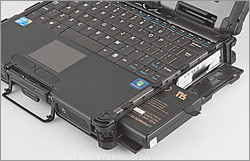
Click to enlargeThe Getac V100's battery performance was decent, with the convertible lasting a solid 4 hours and 56 minutes on our LAPTOP Battery Test (web surfing via Wi-Fi). Still, the typical ultraportable lasts about 30 minutes longer, and the Panasonic Toughbook 19 lasted 7 hours and 45 minutes (though that rugged convertible had a slower Core 2 Duo CPU).
Relying on an Intel Centrino Advanced-N 6200 chipset, the V100 turned in fast wireless throughput both at 15 feet (41.8 Mbps) and at 50 feet (25.3 Mbps). Also included is Bluetooth, and Gobi 2000 mobile broadband is an optional upgrade.
Configurations and Software
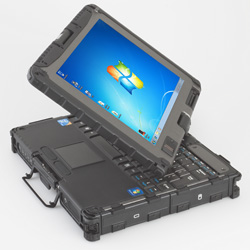
Click to enlargeAt $4,499, our Getac V100 configuration is on the high end of the line, which ranges in cost from $3,699 to $4,649. Unique to our test model is the 4GB of RAM, 80GB SSD drive, and support for Gobi 2000. Other V100 configurations come with a 320GB mechanical hard drive, 2GB RAM, and GPS connectivity. Keyboard options include a more water-resistant rubber membrane keyboard that's also backlit.
The V100 ships with the 32-bit version of Microsoft Windows 7 Professional. Sparse in the way of software, the device does feature a few helpful utilities. These include G-Manager for providing quick access to system status, a Button Manager for customized mapping of button functions, and an OSDC (On Screen Display Control) panel optimized for touchscreen entry.
Getac backs the V100 with a strong five-year warranty, which covers parts and labor for all components within the system. A toll-free number is provided during Pacific business time hours for technical support along with help via e-mail.
Verdict
The $4,449 Getac V100 certainly isn't cheap, but it's competitively priced for a fully rugged convertible tablet with such advanced components. For example, a Panasonic Toughbook 19 with a 1.2-GHz Core i5-540UM processor, 2GB of RAM, and a mechanical 160GB hard drive costs about $3,500, whereas the Getac comes with a Core i7 CPU, 4GB of RAM, and an 80GB SSD. If you don't need something as rugged as the V100, the Touchbook C1 offers comparable performance and battery life in a much lighter package for $2,829. But if you need a convertible tablet that will shrug off even the stiffest abuse, the V100 is for you.
Getac V100 Specs
| Bluetooth | Bluetooth 2.1+EDR |
| Brand | Getac |
| CPU | Intel Core i7 U640 1.2GHz |
| Card Slots | ExpressCard, Smart Card |
| Company Website | http://www.getac.com |
| Display Size | 10.4 |
| Graphics Card | Intel GMA HD |
| Hard Drive Size | 80GB |
| Hard Drive Type | SSD Drive |
| Native Resolution | 1024x768 |
| Operating System | MS Windows 7 Professional (32-bit) |
| Ports (excluding USB) | Modem, Headphone/Mic, Ethernet, VGA, USB/eSATA, serial, security lock slot |
| RAM | 4GB |
| Size | 11.4 x 8.74 x 1.93 inches |
| Touchpad Size | 2.4 x 1.75 |
| USB Ports | 2 |
| Video Memory | Shared |
| Warranty/Support | 5 Year |
| Weight | 6.2 pounds |
| Wi-Fi | 802.11 a/g/n |
| Wi-Fi Model | Intel Centrino Advanced-N 6200 |
